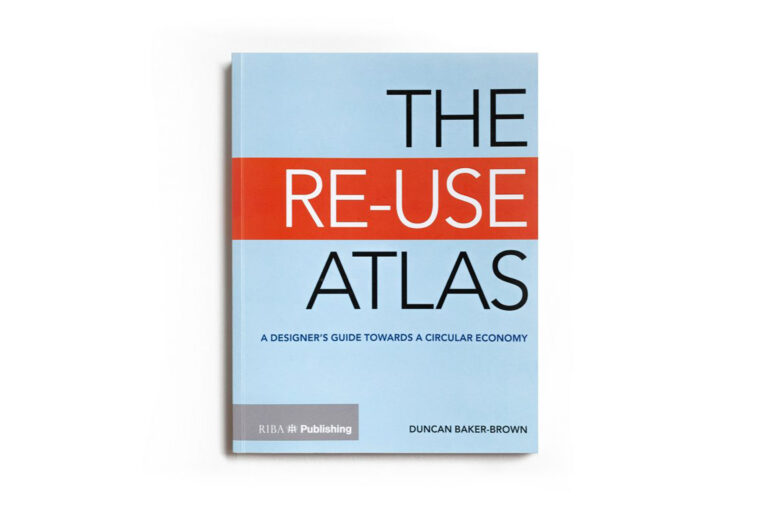News: 9th February 2017
An insight into the Re-Use Atlas No. 3
The Re-Use Atlas: A designer’s guide to the circular economy
Author: Duncan Baker-Brown RIBA FRSA
Entry number 3
Would you like to visit the previous entry? Click here
Since the Waste House was completed in June 2014, Duncan Baker-Brown has been working on a book that considers the challenges and opportunities presenting designers and clients who wish to ‘mine the anthropocene’, i.e.work with existing places, communities and stuff previously mined and processed. Duncan’s book is entitled ‘The Re-Use Atlas’. It will be published in May 2017. However, this blog will give people the opportunity to read parts of the book before the publishing date. Enjoy!
About: This book is a highly illustrated ‘atlas’, taking the reader on a journey, via four distinct ‘steps’ (recycling, reuse, reduce, closed loop), from our current ‘linear economy’ towards a system emulating the natural world, i.e, a ‘circular economy’. Featuring over 25 detailed case studies describing design exemplars from the worlds of textile & fashion design, product design, interior architecture, architecture and urban design, its purpose is to show designers how they can successfully navigate and exploit the emerging field of resource management and the circular economy. Each step is supplemented with an in depth interview with an expert who is successfully tackling one or more of these challenges that present all designers today. This atlas has contributory essays from, among others, Prof. Walter Stahel of the Product-Life Institute, and Prof. Jonathan Chapman who wrote ‘Emotionally Durable Design’.
- Optimistic take on the sustainable design
- Includes illustrative, international projects at different scales
- Shows designers and students how they can positively affect change in this area
This part of the re–use atlas is a series of ‘steps’ towards the reality of a circular economy. Many people are busy visioning what this will look like. However, these visions are a long way from the linear way most people currently exist on the planet – finding stuff, processing, utilising and casting it aside. The idea of designing things in such a way as to ensure they are always a useful resource for either the natural or synthetic worlds is quite alien.
In the meantime, many ideas and concepts that consider living in harmony with natural ecosystems have gained in popularity. Green/ eco/low-energy/Passivhaus/hacking/reuse cafes/upcycling/ designing for demolition, etc are all words and ideas that more and more people are getting to grips with.
While considering the idea of this book, I was concerned that there are many different interpretations of what it means to be a ‘green’ designer. I am also aware that many ‘reuse’ and ‘being less harmful to the environment’ ideas are dismissed within Cradle to Cradle philosophy as simply slowing down the inevitable – for example recycling plastic cups into fleeces to wear simply prevents that plastic from being toxic ocean waste for a couple of years. I feel that this over-simplifies some initiatives that are positively influencing behavioural change.
The ideal of a circular economy is clear, but I am concerned that it appears to be such a big leap from where we currently stand that there is a need for some clearly defined stepping stones to help us along our way to a more circular existence.
One of the biggest challenges that faces humankind is how to exist without damaging so much of our planet’s natural resources. This is done as we mine for resources, as we refine them, utilise them and then when we throw them away. In one way or another, humankind has managed to practically wrap the landscape with our cities, roads, flight paths and landfill sites, while oceans are filling up with plastic waste: a pretty gloomy state of affairs.
However, most of that development has only happened over the last 150 years or so, and it should be noted that we have only been manufacturing plastic for a little over 100 years. Until biodegradable options are commonly available, there needs to be an emphasis on cleaning up the vast areas of oceans and landscape that are currently contaminated by dangerous waste. This ‘big clean-up’ will create a huge amount of material that in theory could be put to good use, or reuse.
Part 2 of my atlas is divided into four chapters, taking the reader on a step-by-step route towards closed loop systems. Each ‘step’ contains a number of case studies that capture some of my first-hand research, gleaned from interviewing over fifty people involved in inspiring projects from around the world that tackle recycling, re-use, the reduction of resource use, and finally closed loop systems. These case studies are supplemented with one longer interview with a significant protagonist from each of the aforementioned steps. Therefore unless stated otherwise, any comments quoted from people in the case studies have been taken directly from interviews I have had personally with them.
The first case study will be part of the 4th blog in this series and is entitled “Adidas training shoe, developed in partnership with Parley for the Oceans”. This blog is due to be published next week.
Step 1 – Recycling Waste

Step 2 – Reusing Waste

Step 3 – Reducing Waste

Step 4 – The Circular Economy

